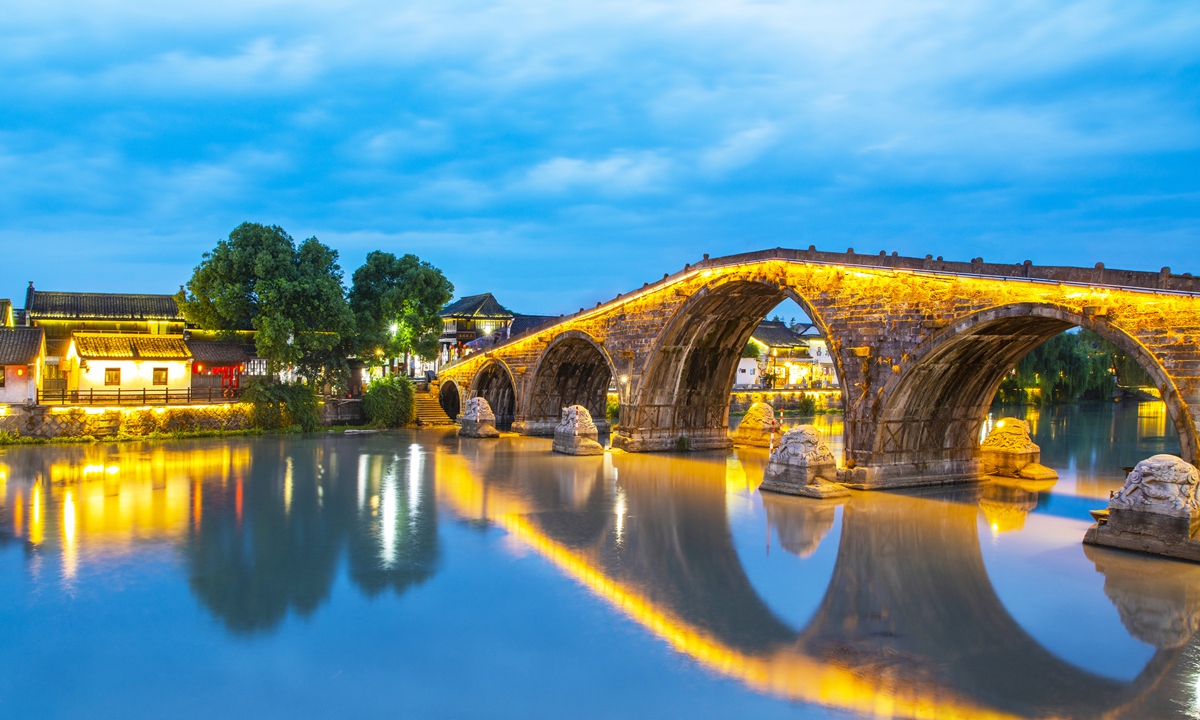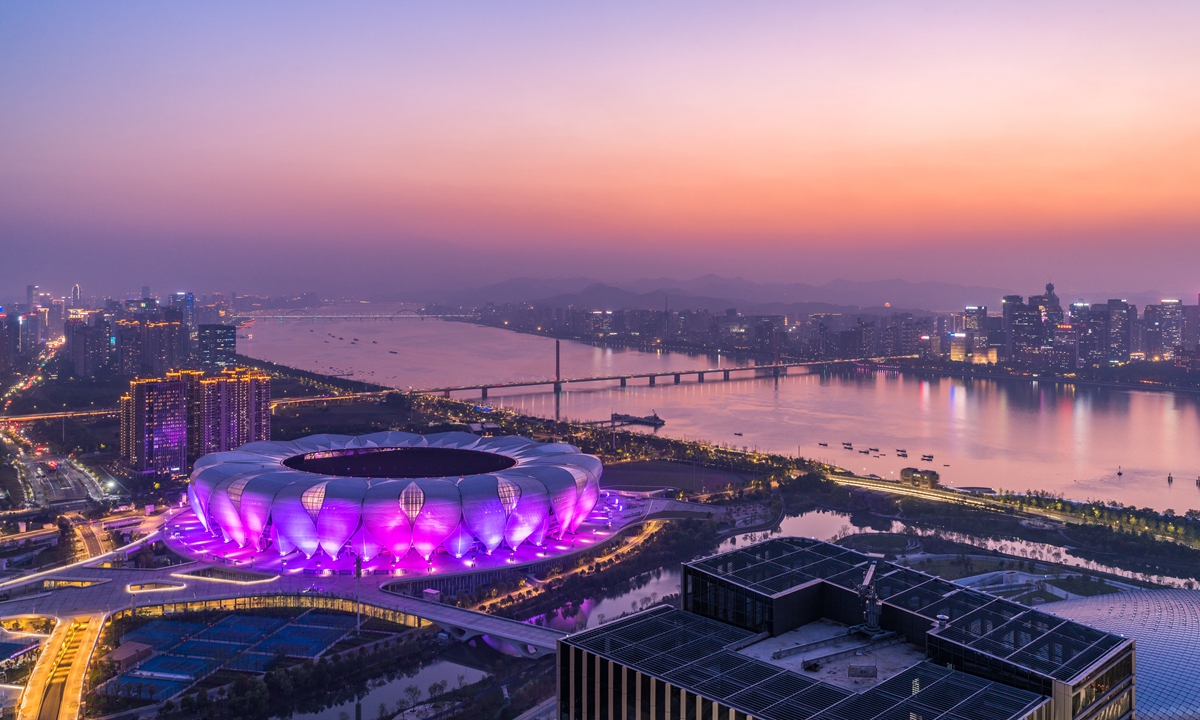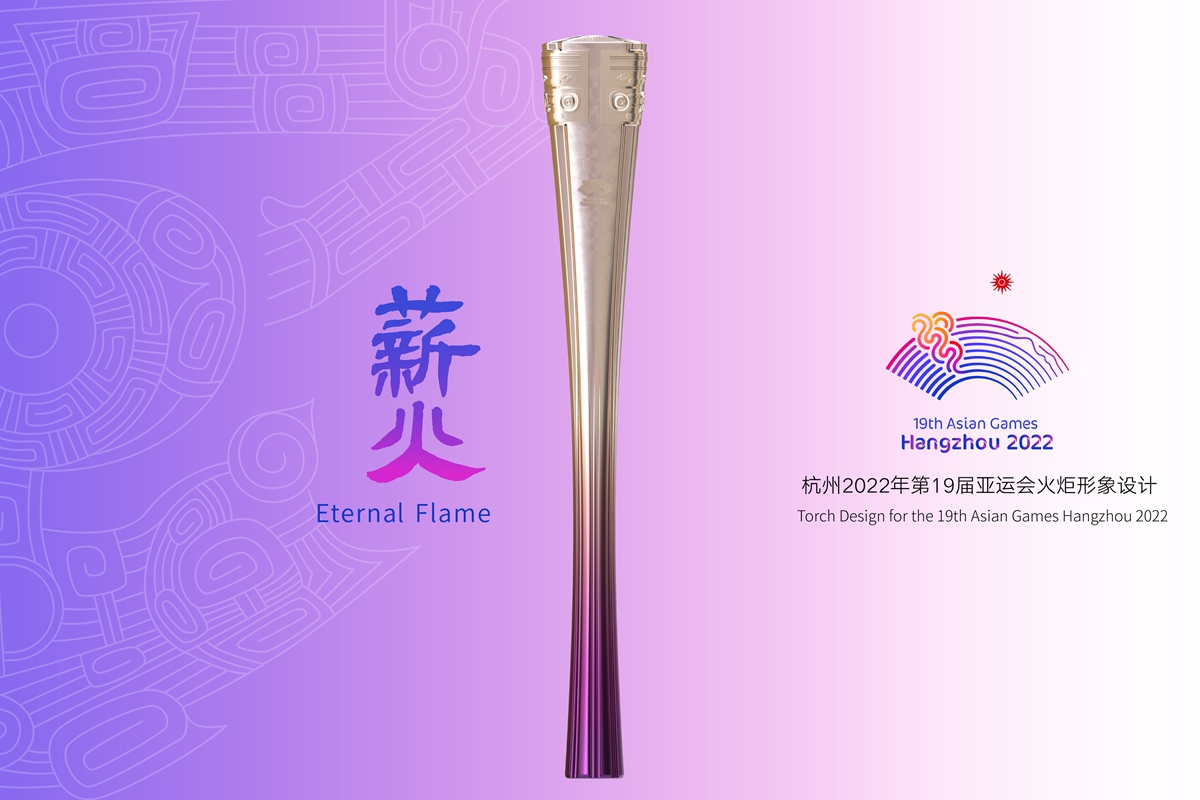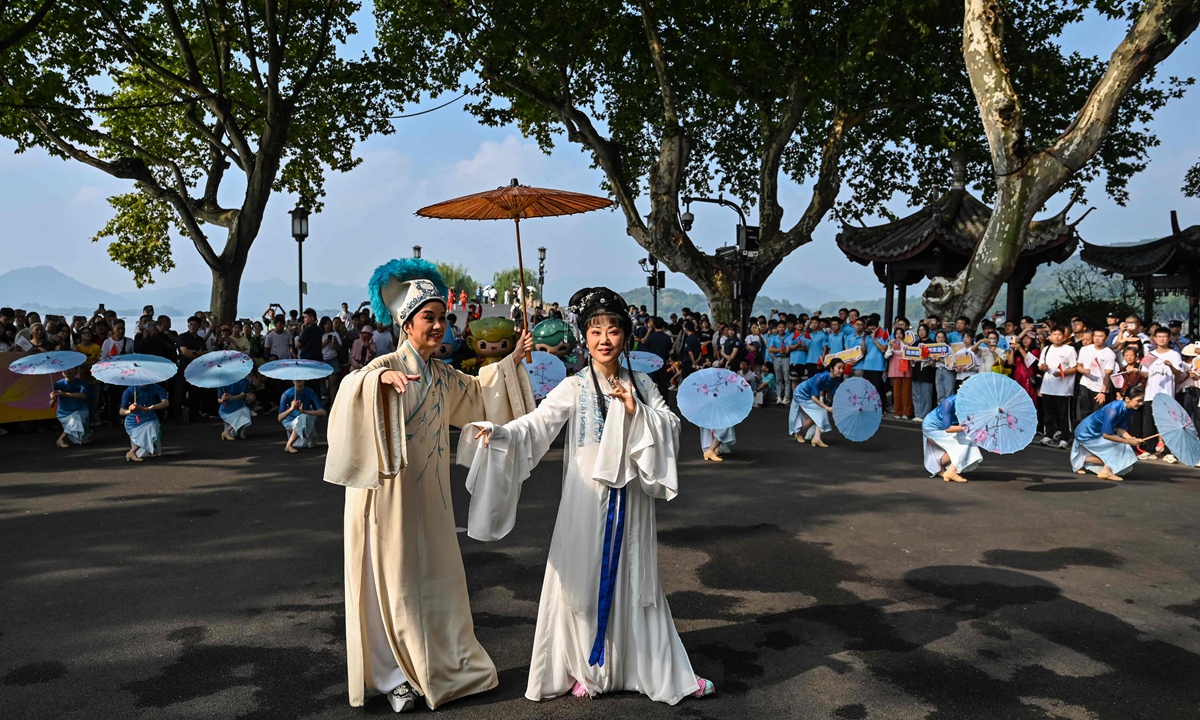
The Gongchen Bridge, a historic stone arch bridge over the Grand Canal in Hangzhou Photo: VCG
Editor's Note:
Chinese President Xi Jinping not only greatly values culture, he has also developed a profound understanding of it.
For him, culture plays a unique and irreplaceable role in the rejuvenation of the Chinese nation and the building of a global community of shared future. He speaks for Chinese wisdom, which has been passed down for millennia, advocates for mutual prosperity of global civilizations, welcomes the flourishing of popular cultural products, and encourages young people to inherit and reinvent their proud traditions.
As Hangzhou gears up for the 19th Asian Games, both the city and the hosting of the event have reflected the five prominent features of Chinese civilization wisely pointed out by President Xi at a meeting on cultural inheritance and development.

The Hangzhou Olympic Center Stadium, where the Games' opening ceremony will take place Photo: VCG
During the flame lighting ceremony for the 19th Hangzhou Asian Games, 19 flame collectors dressed in saintly white slowly ascended the steps at the Liangzhu Ancient City Ruins Park.
Moving forward, one of them lit a torch using a concave mirror that collected the rays of the sun. Amid the melodious music, actors dressed in ancient costumes incorporating elements of the Liangzhu Culture converged from all directions, representing members of the Asian family. Symbolizing peace, friendship and the belief in an Asian community of shared future, they formed a procession that represented all the participants who, guided by the Asian Games' flame, will unite, strive and pursue excellence.
First established around 3000 BC, the ancient city of Liangzhu was the first-ever regional "state" in China and even East Asia, ushering in the development of a profound culture.
At a meeting on cultural inheritance and development in June, President Xi Jinping said China's excellent traditional culture has many important elements that have jointly shaped Chinese civilization through five prominent features - continuity, originality, uniformity, inclusivity and peaceful nature.
The country's long-lasting civilization has been an almost infinite source from which China has drawn wisdom and strength, enabling it to achieve excellence and create a magnificent picture of human civilization when collaborating with countries around the world.
Originality contributes to consistency
Over 5,000 years ago, ancient Chinese seeded the roots of the Chinese nation during the Neolithic period. It is believed that the Xia Dynasty (c.2070BC-c.1600BC), the first dynasty in traditional Chinese historiography, was established in Liangzhu. Now, the spirit of the Asian Games continues the inheritance of human's civilization in the same place.
"It would be impossible to understand ancient China, or modern China, let alone future China, if one does not understand China through the continuity of its long history," Xi said.
"Prominent consistency is the most distinctive and fundamental characteristic of Chinese civilization," Wang Xuebin, a professor at the Party School of the CPC Central Committee (National Academy of Governance), told the Global Times.
Furthermore, the consistency of history does not only refer to the continuity in the linear dimension, but actually has "a very broad and profound meaning," as it "complements and integrates with the four other features."
Besides athletics, the 19th Asian Games in Hangzhou unmistakably carries ancient wisdom from the first glance, as it embraces design legacies that speak for the continuity in Chinese cultural and historical aesthetics.
The Fuyang Silver Lake Sports Center, one of the Asian Games' main venues, was inspired by China's Yuan Dynasty (1279-1368) landscape painting Dwelling in the Fuchun Mountains.
Designers have incorporated the mountain outlines from the classic Chinese art form into the modern building's silhouette. The facade of the stadium has also been "painted" with Dwelling in the Fuchun Mountains, yet through technological means: Over 34,000 rotating louvers play with the changing natural sunlight to create a unique visual charm that echoes the euphemistic elegance of the region south of the Yangtze River.
Architect Yuan Han told the Global Times that classic design symbols like the "landscape painting" represent the "essence of Chinese taste." They will "never age" and can continue to inspire modern designs since the Chinese taste was "intrinsically formed based on the country's long history and civilization."
"Incorporating them in modern designs can expand their cultural value, but designers need to find a creative ancient-and-modern path," Yuan noted.
The Fuyang Silver Lake Sports Center is not the only creative design at the Asian Games. The three mascots - Congcong, Lianlian and Chenchen - were created to combine both Hangzhou's "high tech" character with the ancient Liangzhu Culture.
Zhang Wen, the mascots' designer, told the Global Times that the Liangzhu culture's iconic jade cong (a long square jade tube) inspired mascot Congcong's matte yellow color, while the blue Chenchen was inspired by the Grand Canal, the world's longest man-made waterway which runs all the way to Beijing.
Zhang told the Global Times that China's diverse yet deep civilization gave him the confidence to "re-master traditional Chinese designs but still keep their cultural genes."
"Ancient Chinese culture has a life force, it can evolve creatively over time," Yuan noted.
Robert Walker, an Emeritus Fellow at Green Templeton College, Oxford University, and a professor at Beijing Normal University, told the Global Times that China boasts a rich history of innovation in art and industry, including silk fabric, ink, lacquerware, paper, engraving, woodcuts and printing, as well as the amazing continuity in their use.

Eternal Flame, the torch of the Hangzhou Asian Games
Uniformity and external inclusion
With the approach of the Asian Games, the host city is showcasing its inclusivity through a series of unified measures with increasing meticulousness and enthusiasm for all parties involved.
To present a modern and civilized Hangzhou, the Hangzhou Comprehensive Service Center for Persons with Disabilities and the Hangzhou Metro initiated a voluntary service cooperation. Wang Yilin, the deputy director of the center, explained that through strengthening personnel exchanges and conducting business training, they hope to unify the learning of professional etiquette and skills for assisting persons with disabilities. It aims to encourage more individuals with disabilities to leave their homes and contribute to building an inclusive, fair, and friendly civilized city.
The host city is showcasing many elements of the Asian Games that embody Eastern culture and aesthetics, allowing the world to see a city that is dedicated to promoting mutual learning and appreciation of Asian civilizations. This can be seen from one of the slogans for the 19th Asian Games, "Heart to Heart, @Future," which reflects the ability of the digital age to connect people from all over the region, and the Asian Games torch, which incorporates the Liangzhu jade cong and features humanistic history and natural landscapes. The host city is committed to showcasing culture, making the Asian Games a "bridge" to enhance mutual learning and appreciation of Asian and even global civilizations.
"Chinese civilization is inclusive, which fundamentally determines the historical orientation of the Chinese nation's exchanges and integration, the harmonious coexistence of diverse religious beliefs in China, and the openness of Chinese culture to world civilizations," Xi said at the June meeting.
"Exchanges, communication and cultural blending" are three fundamental values that contribute to the "inclusive" character of Chinese civilization, Xiong Kunxin, a professor and forerunner of China's national ethics research at Minzu University of China, told the Global Times.
Xiong said that China's ability to embrace different cultural beliefs has been a "historical tradition" starting from the "inseparable relationship" between the country's various ethnic groups. The historical tea-horse trade between the Han people and Tibetan ethnic group during the Song Dynasty (960-1279) is a classic example.
Chinese historian Fang Gang told the Global Times that the Chinese interpretation of inclusivity is also "graceful and creative." Taking Buddhism as an example, Fang said that China has never "snatched another country's culture," instead it only embraced them, making them "localized with our own cultural virtues."
Hangzhou has been an important port of trade and cultural exchange since the Tang (618-907) and Song dynasties. It attracted a large number of monks from Japan. There were 109 Japanese monks who came to Hangzhou to learn Buddhism and this has made temples such as the Lingyin Temple and the Jingshan Temple the major cultural exchange venues by that time.
While exchanging with Japanese Buddhist philosophies, the development of the local Hangzhou Buddhism blended with China's unique Confucius and Taoist aesthetics.
Throughout history, ancient China showed its inclusive nature while also implementing various effective measures to promote unity among its multicultural population.
"Chinese civilization is characterized by strong uniformity, which is why different ethnic cultures of the Chinese nation are integrated, and can rally close together even when faced with major setbacks. It determines the common belief that the homeland cannot be divided, the country cannot be destabilized, the ethnic groups cannot be separated, and the civilization cannot be disrupted," Xi said at the meeting.
Xing Guangcheng, head of the Institute of Chinese Borderland Studies at the Chinese Academy of Social Sciences and one of the chief editors of the newly published book History of National Unification in Qing Dynasty, told the Global Times that China, as a multi-ethnic nation, has not always maintained a long-standing unified state throughout its history. Instead, it has experienced cycles of unity and division, eventually forming its present state.
He emphasized that patriotism is a precious core value of traditional Chinese culture, while ethnic unity is a profound historical legacy and an important characteristic of traditional Chinese culture. A strong cultural identity is a distinct historical feature of traditional Chinese culture, representing the deepest level of identification within the national Chinese community.
Performers take part in a performance before the start of the Asian Games torch relay in Hangzhou, Zhejiang Province on September 8, 2023. Photo: VCG
Peaceful nature shapes harmonious world
As the 19th Asian Games torch relay continues, the carrying of the flame symbolizes unity, civilization and peace.
"China is not a culture of the individual. Its success lies in the ability of its people to work together for the common good," said Walker.
"Although China already had the world's largest sailing fleet by the time of the Song Dynasty, it has never sought conquests overseas."
China is committed to fostering dialogue and communication among different civilizations and has proposed initiatives such as the Belt and Road Initiative, Global Development Initiative, Global Security Initiative, and Global Civilization Initiative.
The consistent, original, inclusive, unified, and peaceful nature of Chinese civilization serves as an inspiration for global cultural exchanges and cooperation, promoting understanding and mutual respect among diverse societies.
With the glorious lighting of the Asian Games flame in the city which has readied itself with traditions of hospitality and modern facilities for the Games, Hangzhou will witness another event where China will continue to strive for a shared future based on common values, fostering a harmonious world where different cultures can flourish together.



